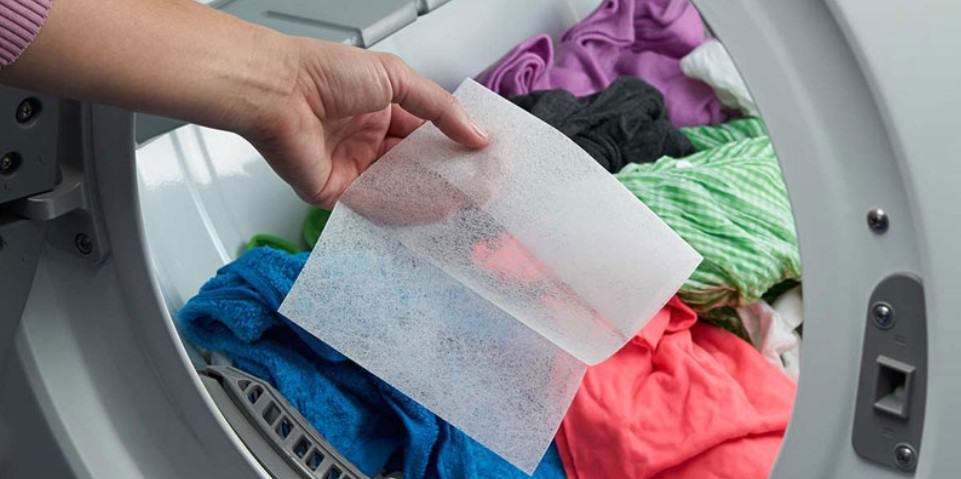Sometimes, there can be this uncomfortable and unsettling type of feeling when you hold or wear your clothes. It can be alarming, especially if it’s the first time. This uncomfortable feeling can be an electrostatic charge on your clothes. In these situations, it’s very helpful to know how to get rid of static in clothes.
What Is a Static Cling?
In a general sense, static cling is the tendency for things to stick together because of static electricity. This phenomenon is very common in clothes but also happens to other things like dust, plastic, and others.
In clothes, static cling occurs because of the triboelectric effect that happens when pieces of different fabrics are rubbed against each other.
Clothes having contact and rubbing with other fabrics create an electrostatic charge that mainly occurs when washing and drying them. Static clothes most commonly occur in your dryer. The differently charged surfaces attract each other and so cause the static.
Static In Cold Temperatures
During the winter, when the temperature is low, problems like this are more noticeable. The low humidity exacerbates this phenomenon and allows the electricity to build up. Worry not, there are ways to get rid of static in clothes.
Getting Rid of Static from Your Clothes
When you get the weird feeling of a static charge on your clothes while wearing them, it would be very helpful to know the ways in which you can get rid of it. Here are some methods you can follow.
The Wire Hanger Technique
Electrons are the cause of the static charge on your clothes, and metal is a good conductor. The hanger is a great tool to help sweep away the electrons that are causing the charge. The steps are easy and not at all complicated.
You just need to run the metal hanger along the inside of the clothing. This method works well with silk! You can run a metal hanger before or after you wear the clothing so the static is controlled.
Anti-static spray
Yes, there are anti-static sprays available in the market. You can also make your own as follows.
Fabric softener magic!
Using fabric softener helps cut down on the static tendencies of your clothes. The twist in this method is that you don’t pour and apply the fabric softener while washing the clothes, but instead, right when the clothes are ready to wear.
For this method, you would need to prepare a spray bottle with water, and a tablespoon of fabric softener. When you get all these things prepared, mix them together to form a solution. The last step is to spray the solution on your clothes.
More Simple Ways to Get Rid of Static in Clothes
Dryer sheets
While dryer sheets are also used the way dryer balls are used, they also prove helpful in certain situations. These sheets are helpful, especially when you are having a static emergency. Dryer sheets have fabric softeners, and fabric softeners contain anti-static agents. And so, a quick swipe on the area would be a great help.
Lotion rubs
Lotion also helps in keeping static at bay. Perhaps you are outside running some errands and you feel a static charge on a certain area of your clothes. You can just get a lotion and rub a bit of it on the part. When the lotion dries, the static charge goes with it.
Hair spray
Yes, hair spray does not only work on your hair but also helps get rid of static charges when there is a static charge. You can turn your clothes inside out and hold the spray at a distance of at least 30 cm to avoid any unwanted wet or damp spots.
Safety pin
Just like how a metal hanger sweeps away electrons and gets rid of static charge, a safety pin helps reduce and prevent static charge as well. This small material will hold some of the charge that would help in preventing static buildup throughout the day. You can attach a safety pin to your clothes somewhere not visible.
Shoe change
If you are wearing rubber-soled shoes, change into another pair, preferably leather. In leather, it doesn’t build up electrical charges as easily as they do in rubber.
Freeze method
Yes, your freezer stores food for you and helps it stay fresh. Aside from that, you can also place a charged sweater or a piece of clothing. Place your clothes in the freezer for at least 30 minutes. This way, the process discharges the static electricity from your clothing.
Preventing Static Charges on Your Clothes
Prevention is better than cure. And so, to avoid feeling the static charge and your fabrics sticking to each other, it would be helpful if you prevented the charge before it even happened. Here are some ways to do so.
Applying moisturizer
Static charges form and thrive in dry environments. And so, adding moisture to your skin will prevent you from encouraging static charge. Dry skin can encourage static charges, and applying moisturizer or lotion can reduce the risk of static in clothes while you wear them.
Dryer balls
They may look like your pet’s chew toy, but they are actually very helpful tools in preventing static charge. Tossing some dryer balls into the pile of clothes in the dryer will reduce the contact between the fabrics.
You can make your own dryer balls by crumpling aluminum foil into balls about the size of a plum, just large enough for one hand to grasp, and toss them with your clothes. A tennis ball also works!
Dryer sheet
A dryer sheet is not only ideal for preventing the buildup of static in the dryer but also contributes to making your clothes smell nice.
Shake, shake, shake!
After washing and drying, get your clothes one by one and give them a good shake. Ideally, 2-3 quick shakes would be enough to prevent static charge from setting in, especially when you will be placing your clothes on another surface.
Boost humidity
Overly dry air is also a factor that encourages static charges. You can boost the humidity in your home by purchasing a humidifier.
Fabric softeners
Fabric softeners help to give your clothes a nice smell while also preventing static electricity from accumulating. Fabric softeners have chemicals that are specially designed to stop electricity from building. Plus, it helps your clothes be extra soft!
Vinegar and foil
While you are washing, you can add a little bit of vinegar to your load of clothes. Take note to not mix it with bleach, as harmful gas may be formed. Along with the vinegar, add a piece of tin foil rolled into a ball. Do not put the tin foil into the dryer.
Materials That Cause Static Charges
Not every type of material possesses the same level of vulnerability when it comes to static charges. Some create or cause more static electricity than others. To clarify, all fabrics have the tendency and capability to build up static charges. It’s just that some fabrics generate more static and are more vulnerable to static charges. These materials include:
Polyesters
When in contact and rubbed against another piece of synthetic material or a material with an opposite charge, this material creates a static charge. Synthetic fibers like nylon tights are usually moisture free and static thrives in dry environments.
Acrylics
Acrylic is an excellent static charge generator. Wiping an acrylic surface back and forth creates both positive and negative charges that attract small particles.
Fur
Fur is even often used as a fabric that creates a static charge.
Rayon
Synthetics are often good conductors and encouragers of static charge. How about semi-synthetics like rayon? The answer is yes. Semi-synthetics still create a dry environment, thus allowing static charge to occur.
Fabrics That Are Least Vulnerable to Static Charge
Neutral
There are also materials that do not give up or attract electrons when in contact or rubbed against other materials.
Cotton
Cotton is a neutral fabric amongst the fabrics you encounter in your daily life. Cotton is a natural fiber, which means it absorbs moisture from the air or your body. This process makes the fabric conductive and therefore more likely to drown the static charge even as it builds up.
Leather
Leather does not conduct static charge, and if you ever see dust covering your leather gear, it’s probably not because of static charge.
Combinations
It takes two to tango! And so, there are pairs of materials you need to keep away from each other when washing or mixing and matching as much as you can.
- Dry skin and polyester – Dry skin has a high probability of being highly positively charged, whereas polyester clothing is typically negatively charged. As a result, the “static” feeling is created.
- Silk and glass
- Fur and plexiglass rods
- Saran wrap
Summary
Static clothes can be really uncomfortable and can happen often, especially when the environment is especially dry and moisture is low. Knowing how to get rid of static in clothes is essential just in case you encounter the static feeling or notice your clothes sticking together uncomfortably. This way, you can get rid of the charge easily.

Jessica Oliver is a fashion enthusiast with more than ten years of experience in the industry. She previously managed her own clothing store in New York before becoming a mother of three. With a passion for sustainability and a desire to share clothing care and recycling tips.









